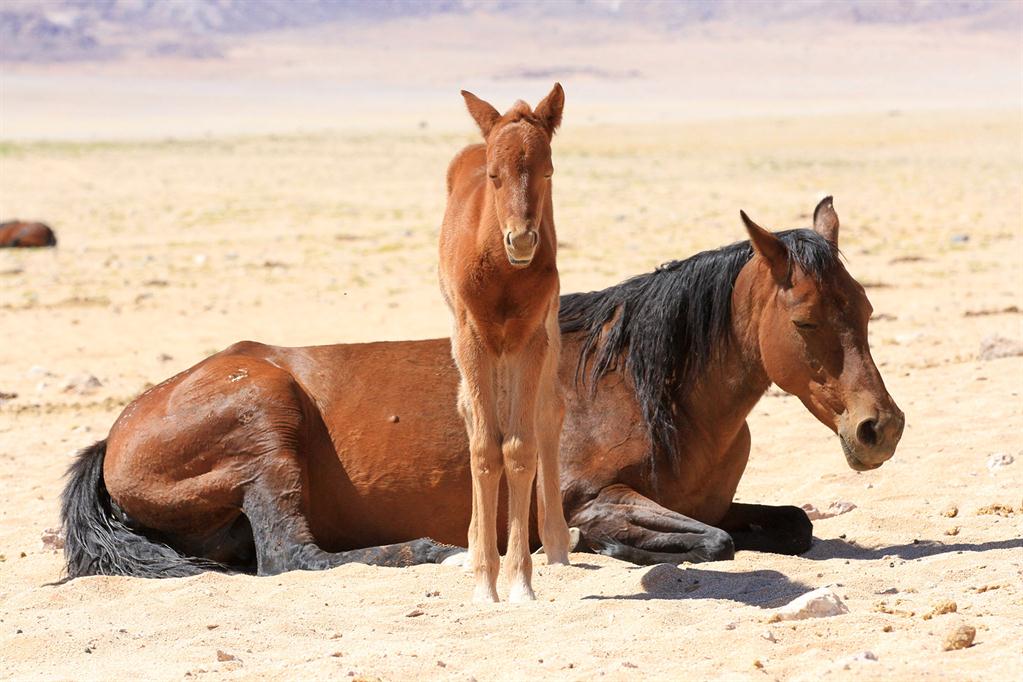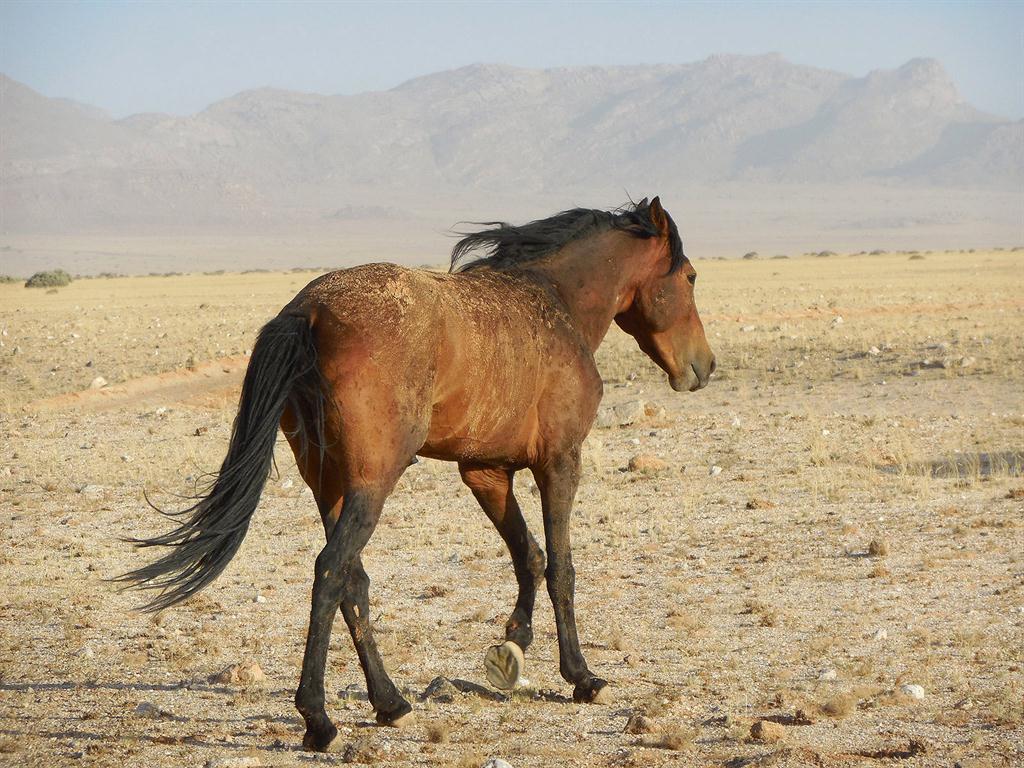Extinction looms
Namibia's wild horse population has plummeted from around 300 to a mere 80 horses since 2013.
The environment ministry has been urged to take immediate action before Namibia's entire population of wild horses is decimated.
The number of wild horses of the Namib has plummeted from around 300 to a mere 80 horses since 2013.
According to a statement by the Namibia Wild Horses Foundation, the past five years has been extremely harsh for the wild horses, with severe drought and predation by a pack of spotted hyaenas that had moved into the area decimating their numbers.
“The lives of the horses are still in danger,” the foundation said.
According to biologist Dr Telané Greyling, who has studied the wild horses for more than 20 years, and who works closely with the foundation, not a single foal has survived since 2012, making the youngest horse six years old.
“In 2013 alone, the hyaenas killed about a 100 horses, of which 50 were foals,” she said.
The long-awaited rainfall this year brought new hope and allowed the foundation to stop feeding the horses after 27 months of drought, in which the public generously donated both feed and funds to keep the horses alive.
According to the foundation, the pack of hyaenas also moved onto adjacent farmland, leaving the horses in peace. The first foals were born and it started to look as if the wild horses finally stood a chance.
“Unfortunately, the respite was short-lived. The hyaenas returned with a vengeance, killing three of the four foals born since September, once again threatening the century-old population.”
According to the foundation, tracks and drag marks were found leading to the hyaena den over the weekend - a clear indication that the last foal had been taken by the hyaenas.
“The pack will now, once again, predate on the adult horses, targeting mainly the mares until not a single one is left.”
The foundation says it strongly believes the horses are teetering on the brink of extinction. It says even with the last good rains, there is no chance of foals surviving, as long as the hyaenas are around. It added the hyaenas have already resumed targeting the adult horses.
“The population is already depleted, with only 33 mares remaining and the genetic integrity of the population is at risk.”
According to foundation chairman Mannfred Goldbeck, they are waiting anxiously for the environment ministry to respond to their request regarding the custodianship of the horses.
“We need to implement measures urgently to safeguard their future. We have been trying for several years to engage with the ministry, without success. The situation is now an emergency. We urge the ministry to commit to a plan of action so that we can save the remaining population.”
The foundation has been in dialogue with the ministry since 2015.
“The ministry has been reluctant to manage the hyaenas, as it has a non-interference policy regarding the wildlife in national parks, yet it wants the horses to remain in the Namib Naukluft Park, where without intervention their future is certainly doomed,” the foundation said.
It said the ministry is also unwilling to grant the foundation custodianship of the horses, which would enable it to find suitable land elsewhere and relocate the horses to ensure their survival.
“This unwillingness to manage the situation or to pass on custodianship means certain death for the population.”
According to the foundation it desperately wants to help the horses, but their hands are tied, unless the ministry grants them custodianship.
The wild horses of the Namib are among the top ten tourist attractions in Namibia. They have been the subject of numerous documentary films and are used to promote Namibia as a popular tourist destination. They are an important part of Namibia's history and heritage. The loss of this population will do untold damage to brand Namibia.
“If the ministry does not act, the world will look askance at Namibians, who let their population of wild horses die on their watch, when simple solutions were readily available. The future of the wild horses is in your hands and time is fast running out. The clock is ticking. The situation is critical. The Namibian wild horses are on the brink of extinction.”
ELLANIE SMIT
The number of wild horses of the Namib has plummeted from around 300 to a mere 80 horses since 2013.
According to a statement by the Namibia Wild Horses Foundation, the past five years has been extremely harsh for the wild horses, with severe drought and predation by a pack of spotted hyaenas that had moved into the area decimating their numbers.
“The lives of the horses are still in danger,” the foundation said.
According to biologist Dr Telané Greyling, who has studied the wild horses for more than 20 years, and who works closely with the foundation, not a single foal has survived since 2012, making the youngest horse six years old.
“In 2013 alone, the hyaenas killed about a 100 horses, of which 50 were foals,” she said.
The long-awaited rainfall this year brought new hope and allowed the foundation to stop feeding the horses after 27 months of drought, in which the public generously donated both feed and funds to keep the horses alive.
According to the foundation, the pack of hyaenas also moved onto adjacent farmland, leaving the horses in peace. The first foals were born and it started to look as if the wild horses finally stood a chance.
“Unfortunately, the respite was short-lived. The hyaenas returned with a vengeance, killing three of the four foals born since September, once again threatening the century-old population.”
According to the foundation, tracks and drag marks were found leading to the hyaena den over the weekend - a clear indication that the last foal had been taken by the hyaenas.
“The pack will now, once again, predate on the adult horses, targeting mainly the mares until not a single one is left.”
The foundation says it strongly believes the horses are teetering on the brink of extinction. It says even with the last good rains, there is no chance of foals surviving, as long as the hyaenas are around. It added the hyaenas have already resumed targeting the adult horses.
“The population is already depleted, with only 33 mares remaining and the genetic integrity of the population is at risk.”
According to foundation chairman Mannfred Goldbeck, they are waiting anxiously for the environment ministry to respond to their request regarding the custodianship of the horses.
“We need to implement measures urgently to safeguard their future. We have been trying for several years to engage with the ministry, without success. The situation is now an emergency. We urge the ministry to commit to a plan of action so that we can save the remaining population.”
The foundation has been in dialogue with the ministry since 2015.
“The ministry has been reluctant to manage the hyaenas, as it has a non-interference policy regarding the wildlife in national parks, yet it wants the horses to remain in the Namib Naukluft Park, where without intervention their future is certainly doomed,” the foundation said.
It said the ministry is also unwilling to grant the foundation custodianship of the horses, which would enable it to find suitable land elsewhere and relocate the horses to ensure their survival.
“This unwillingness to manage the situation or to pass on custodianship means certain death for the population.”
According to the foundation it desperately wants to help the horses, but their hands are tied, unless the ministry grants them custodianship.
The wild horses of the Namib are among the top ten tourist attractions in Namibia. They have been the subject of numerous documentary films and are used to promote Namibia as a popular tourist destination. They are an important part of Namibia's history and heritage. The loss of this population will do untold damage to brand Namibia.
“If the ministry does not act, the world will look askance at Namibians, who let their population of wild horses die on their watch, when simple solutions were readily available. The future of the wild horses is in your hands and time is fast running out. The clock is ticking. The situation is critical. The Namibian wild horses are on the brink of extinction.”
ELLANIE SMIT






Comments
Namibian Sun
No comments have been left on this article